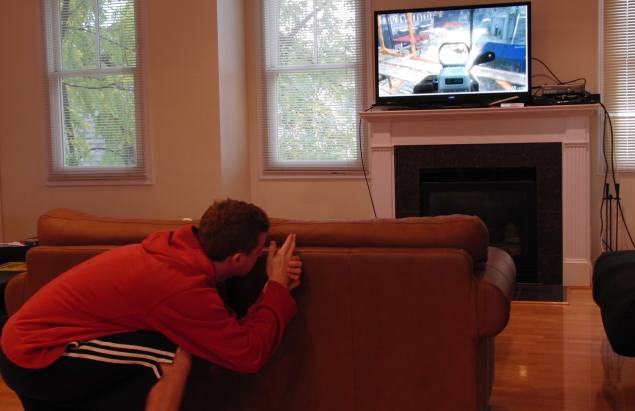- Home
- Games
- Games News
- WiTrack motion sensing technology that can see through walls developed by MIT
WiTrack motion sensing technology that can see through-walls developed by MIT

Imagine playing a video game while moving freely throughout your house.
A revolutionary new technology that uses radio signals to track a person through walls and obstructions could change the way video games are played, scientists say.
Researchers from the Massachusetts Institute of Technology (MIT) have developed the new high-resolution, 3D motion tracking system dubbed "WiTrack," which can pinpoint a person's 3-D location to within 10 to 20 centimetres - about the width of an adult hand.
"Imagine playing an interactive video game that transforms your entire home into a virtual world. The game console tracks you as you run down real hallways away from video game enemies, or as you hide from other players behind couches and walls. This is what WiTrack can bring to video gaming," said Dina Katabi, a professor of computer science and engineering and co-director of the MIT Centre for Wireless Networks and Mobile Computing.
Earlier this year, Katabi and her graduate student Fadel Adib unveiled WiVi, a system that detects humans through walls and can track the direction of their movement using Wi-Fi signals.
( Also see: Low-cost 'nano-camera' developed that can operate at the speed of light )
Based on this earlier work, Katabi and Adib developed WiTrack in collaboration with Rob Miller, a professor of computer science and engineering, and graduate student Zach Kabelac.
In comparison to WiVi, WiTrack has significantly higher accuracy and can track both two-dimensional and three-dimensional movement using specialised radio waves, as opposed to Wi-Fi signals.
WiTrack operates by tracking specialised radio signals reflected off a person's body to pinpoint location and movement. The system uses multiple antennas: one for transmitting signals and three for receiving.
The system then builds a geometric model of the user's location by transmitting signals between the antennas and using the reflections off a person's body to estimate the distance between the antennas and the user.
WiTrack is able to locate motion with significantly increased accuracy, as opposed to tracking devices that rely on wireless signals, said Adib.
The system's ability to track motion through obstructions could make it particularly useful not only in gaming, but also in tracking elderly patients at high risk of falling.
Current approaches to fall detection require individuals to continuously wear sensors or install cameras in the person's home, researchers said.
While WiTrack does not require individuals to wear sensors or install cameras, it can still detect falls with very high accuracy.Get your daily dose of tech news, reviews, and insights, in under 80 characters on Gadgets 360 Turbo. Connect with fellow tech lovers on our Forum. Follow us on X, Facebook, WhatsApp, Threads and Google News for instant updates. Catch all the action on our YouTube channel.
- Samsung Galaxy Unpacked 2025
- ChatGPT
- Redmi Note 14 Pro+
- iPhone 16
- Apple Vision Pro
- Oneplus 12
- OnePlus Nord CE 3 Lite 5G
- iPhone 13
- Xiaomi 14 Pro
- Oppo Find N3
- Tecno Spark Go (2023)
- Realme V30
- Best Phones Under 25000
- Samsung Galaxy S24 Series
- Cryptocurrency
- iQoo 12
- Samsung Galaxy S24 Ultra
- Giottus
- Samsung Galaxy Z Flip 5
- Apple 'Scary Fast'
- Housefull 5
- GoPro Hero 12 Black Review
- Invincible Season 2
- JioGlass
- HD Ready TV
- Laptop Under 50000
- Smartwatch Under 10000
- Latest Mobile Phones
- Compare Phones
- Huawei Nova 15
- Huawei Nova 15 Pro
- Huawei Nova 15 Ultra
- OnePlus 15R
- Realme Narzo 90x 5G
- Realme Narzo 90 5G
- Vivo S50 Pro Mini
- Vivo S50
- Asus ProArt P16
- MacBook Pro 14-inch (M5, 2025)
- Huawei MatePad 11.5 (2026)
- OnePlus Pad Go 2 (5G)
- Huawei Watch 10th Anniversary Edition
- OnePlus Watch Lite
- Acerpure Nitro Z Series 100-inch QLED TV
- Samsung 43 Inch LED Ultra HD (4K) Smart TV (UA43UE81AFULXL)
- Asus ROG Ally
- Nintendo Switch Lite
- Haier 1.6 Ton 5 Star Inverter Split AC (HSU19G-MZAID5BN-INV)
- Haier 1.6 Ton 5 Star Inverter Split AC (HSU19G-MZAIM5BN-INV)












